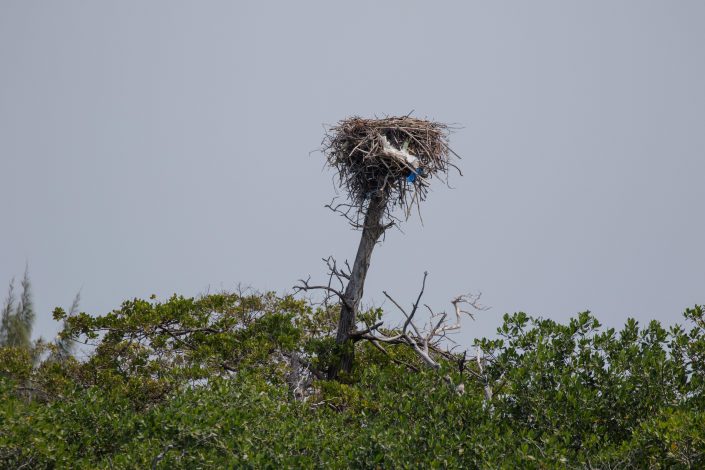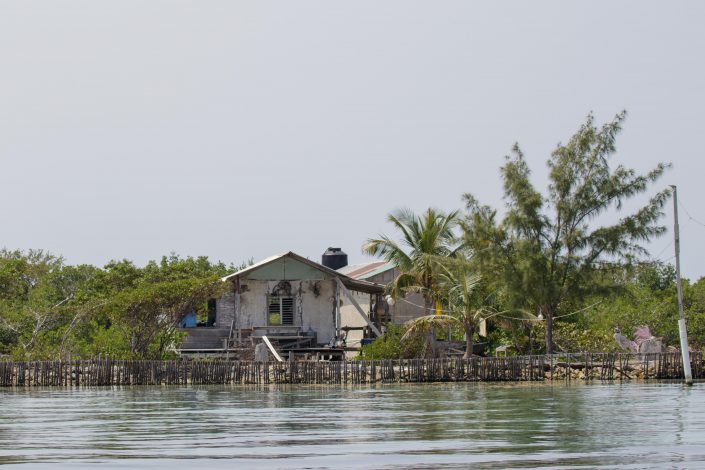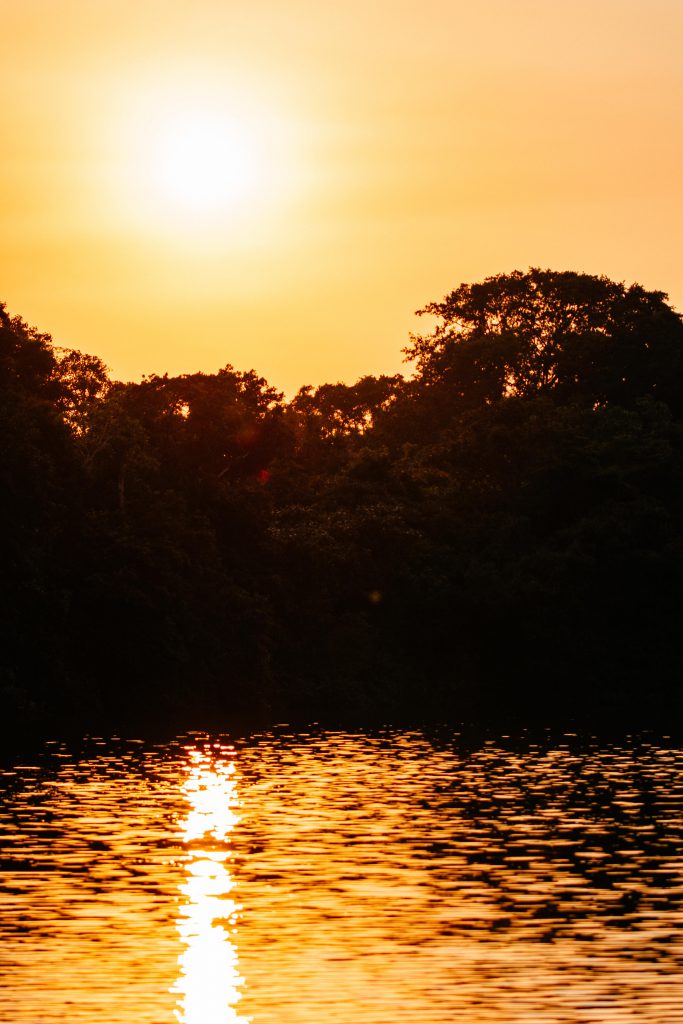Studying the Ridgway’s Osprey of Belize: Part II
Flat calm Caribbean and three young Ridgway’s!

February 18: Second Survey of nests surrounding Placencia
Our second survey began from Placencia, a small beach resort town on the southern coast of Belize, which is a beautiful place to visit if you’re planning a trip to Belize. It was flat calm that morning, which made for great boating, but it was extremely hot! Life in the tropics was finally setting in… We headed towards the first nest location, which was last surveyed in 2016 by Paul and his team. Paul and Alan have been surveying osprey nests in Belize since 2014, so all known nests have been mapped and surveyed over the past couple years. Through the continued surveys of these nests we should be able to determine if the low productivity of Ridgway’s (around .3-.4 young/active nest) can sustain the population in Belize (the southern most nesting colony of Ridgway’s throughout their range). The work performed as a part of these surveys is critical to their long term survival in Belize. The first nest we visited was very unkept; however a pair was present. This ended up being quite the common sight during this survey.



We then motored to several other small Cayes and surveyed a total of eight nests (only two produced young, photos below). Many were abandoned so it was hard for us to determine their overall fate. Many (good looking) nests Paul thought had failed (once had young or eggs and were lost) since the nests did look like they have been used this year but there were no birds around during our survey. Generally it is hard to determine overall nest success unless you watch a nest throughout the entire nesting season, or find evidence of nest failure when visiting a nest. In New Jersey, I generally can tell when a nest fails or hasn’t by observing the behavior of the adults. If a nest is active (bird present) and it is defending its nest with no young or eggs then it failed. If the nest is active (bird present) and it flies away with no defense of nest/young, then I call that nest active and housekeeping (a term for a bird that starts a nest but does not produce any eggs/young). Lastly, a nest with no birds = not active. Either way – it is very difficult to determine the overall nest success with only one visit/nest/season. If I were to go back to Belize then I would go twice during the nesting season there, which runs from December – March/April (once when birds are incubating and once when they have young). 🙂

While we try to determine the cause of failure to an active nest, we think about potential threats to nesting ospreys. A substantial threat to ospreys in coastal Belize should be no surprise to us in New Jersey. Coastal development was a huge contributor to the decline of ospreys throughout coastal New Jersey. In Belize, there are many resorts on the coastal Cayes and the desire for more. Could this be the beginning of the decline of ospreys in Belize?? I hope not, as humans and ospreys can live alongside each other in very close proximity. To develop a Caye, mangroves are first cleared and then sand/coral is dredged onto the island to “fill” it in. Raising the elevation of the island allows buildings to be built and lovely white sand beaches to be manufactured for the enjoyment of humans (and sand flies!). During our survey we saw this in plain view. A nest on Long Coco Caye was still present in a large mangrove tree, however a huge pile of fill dredged into a pile right next to the nest. If this happened during the nesting season then there is no doubt that this nest failed…but, where were the adults?? The more we think about this work and the ospreys of Belize, the more concern we have for their overall safety and stability of their population.






We kept moving along with our survey and ventured outside of the previous survey route to check a small Caye for a nest. Success! We found a nice nest atop a huge almond tree on Moho Caye. Bonus! There were also two large young (5-6 week old young) making this our first productive nest of the day! The island was private and occupied by a friendly caretaker. We talked to him about the ospreys, and he was happy to share the island with them. This just goes to show that ospreys and humans can coexist on the coast of Belize.




We continued to head north and back to Sittee River. Navigating along the edges of the mangrove islands would not have been possible with our experienced captain and his mate, Steve. They really made every survey go extremely smooth. Having boated for the majority of my life, I can attest to the fact that anything can go wrong at any time. You definitely do not want to get into trouble when boating offshore in Belize! There is few other boaters who could offer help, no patrolling of Coast Guard boats, no SeaTow/Boat US, and many islands are totally undeveloped and without freshwater. We are lucky to have had such a great crew to be able to get to us to where we needed to go and then back safely!







The last nest we surveyed on our way back to Sittee River was one on Channel Caye. This nest was remarkable. It was built in a large dead mangrove and had two visible young. After closer inspection with my camera, we believed that their could be three young, so we decided to climb up and use a mirror to get a view into the nest. Jay T. eagerly climbed the short tree and saw three young. The female took off from the nest as the young played dead, as they do in New Jersey. She was not as upset as our ospreys get (Ridgway’s are less disturbed than NJ’s ospreys and hence less aggressive, IMO) and flew over the nest several times and then perched on a nearby branch, which allowed me to get some great photos of her. We were only by the nest for a couple minutes and quickly departed to let her return to the nest. This was the first time that Paul has ever seen three young in a Ridgway’s nest, so very cool for us to see and document! We surely hoped that all three survived to fledge. Usually by the time they reached the age that they were (around 3-4 weeks), then their chances of surviving were much more likely.
All things considered, there are many concerning threats to ospreys in Belize: nest abandonment, coastal development, plastic marine debris, possible persecution?, and the combined threats from the effects of climate change but we can only hope that from our work we can help improve their chances of surviving.
Stay tuned for Part III where we cover the next two surveys out and back from Turneffe Atoll and Calabash Caye!






Part III: Braving the Caribbean Sea to Turneffe Atoll
Discover more from Conserve Wildlife Foundation of NJ
Subscribe to get the latest posts sent to your email.
Leave a Comment
Great report Ben. Wildlife has a tough time all around the globe.
Pretty soon you won’t have to go to Belize to see Osprey. I look forward to seeing you in the Sedges this spring.
Jim
Comments are closed.